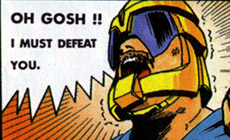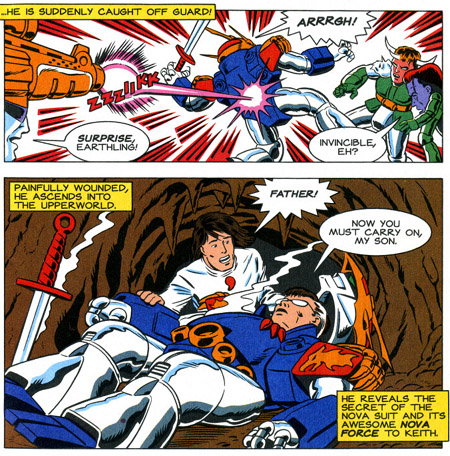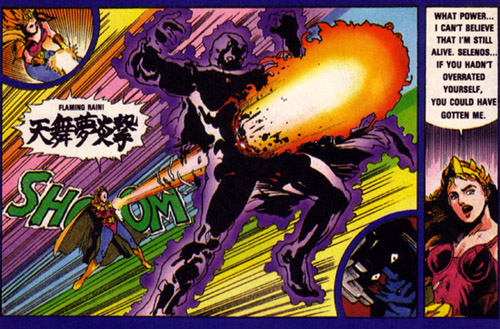The 10 Biggest Videogame Mascot Failures
 |
By Todd Ciolek
Ever since video games actually became an industry, they’ve rarely been satisfied with simply being video games. Some designers and marketers want to deliver nothing beyond a nicely tuned puzzle game or shooter, but there’s often a rather obvious attempt to create the next major mascot character, an icon who’ll sell not only games, but also toys and coin banks and stationery and bed sheets and Happy Meal Toys. One might theorize that the field is already cluttered with too many games about cartoonish, focus-tested characters, but the few successes only serve to convince the gaming industry that the next Pac-Man or Sonic the Hedgehog is only a creatively drawn logo and a chemically precise “attitude” away.
Let’s put this in perspective. Remember Bubsy, the cloying bobcat star of several games and one of the worst cartoons ever? Well, Bubsy was a success by game mascot standards. No, really. He lasted for at least four mediocre games before poor critical reception and rampant public loathing forced him to retire. That’s a runaway hit compared to the forgettable game leads we’re about to explore. We have but one requirement: these failed mascots must appear in actual games, meaning that the TurboGrafx-shilling behemoth Johnny Turbo and other characters that appeared only in ads will just have to wait for another list.
10) Plok
System: Super NES
Year: 1993
Created By: Software Creations
In Plok’s defense, his game isn’t bad. It’s more inventive than the usual B-list mascot stuff, as the title character fires off his arms and legs at enemies, and using up his four shots momentarily leaves him a bouncing head and torso. And that’s where Plok’s troubles start. He’s clearly supposed to be cute and clever, but the game’s vision of a limbless, latex-clad hero is a bit disconcerting. Plok’s head was inspired by an executioner’s hood, and a re-coloring could make him look like a bug-eyed Ku Klux Klansman.
One of many would-be game stars of the 1990s, Plok appeared in only one released Super NES game, though an arcade title was canceled earlier. It’s an open question as to whether kids would’ve liked the vaguely creepy and constantly angry Plok better if he were situated between Street Fighter II and Mortal Kombat machines. Perhaps they would have shelled out quarters in fear of rousing the deep, terrible wrath implicit in his furrowed eyebrows.
9) Rocky Rodent
System: Super NES
Year: 1993
Created by: Irem
Never a huge player in the game market, Irem nonetheless built a reputation for arcade shooters and tightly made action titles like R-Type and Metal Storm. Yet their favored genres were rapidly eclipsed by Sonic the Hedgehog and his attendant imitators during the 1990s, and Irem wanted some o’ that. Their stab at the mascot subculture is named Rocky Rodent and walks around wearing the perpetual leer of a cartoon lecher or a sex offender. It becomes particularly unwholesome during the ending, when Rocky gazes lustfully at the nether regions of the woman he’s just rescued.
Rocky Rodent’s main innovation comes from his changing hairstyles: a spiked coif lets him spear overhead platforms and flip himself up, a mohawk can be hurled like a boomerang, and a long ponytail makes for a Castlevania-style whip. These creative touches are undone by slippery control and generally bland levels. Irem could be forgiven for the game’s lack of style, but one would expect arcade-game specialists to steal Sonic’s concept properly.
8) Keith Courage
System: TurboGrafx-16
Year: 1989
Created by: Hudson, NEC, Sunrise
Also Known As: Mashin Eiyuden Wataru
Remember the TurboGrafx-16? You might not, and you can blame Keith Courage for that. When NEC and Hudson decided to bring the popular-in-Japan PC Engine to the U.S., they needed an ideal pack-in game for the system they’d re-named the TurboGrafx-16. From a lineup that featured future hits like Blazing Lazers and Alien Crush, NEC chose an unremarkable action-platformer based on an anime series called Mashin Eiyuden Wataru. There was, however, a problem: Wataru was completely unknown in America.
And so Wataru became Keith Courage in Alpha Zones, the epic tale of a young man who dons robotic armor (created by his late scientist father) and leads the forces of N.I.C.E. (Nations of International Citizens for Earth) against the menacing creatures of B.A.D. (Beastly Alien Dudes). This was all detailed in a comic included with Keith Courage, which wasn’t changed too much from the original Wataru game. The hero was still a headband-wearing anime kid who hopped across boring stages and then, with the help of a rainbow beam, put on a mecha-suit and hopped across slightly less boring stages. After a few months of Keith Courage, NEC started promoting Bonk, the pin-eyed caveman star of three decent games, as its mascot, and Keith Courage was never seen again.
7) Bug
System: Saturn
Year: 1995, 1996
Created by: Sega of America
Also Known As: Bug!
Bug led a pitiable existence for the two Saturn games he appeared in, as he was only granted life because Sega couldn’t get a proper Sonic game up and running in time for the system’s launch. So the kids and dedicated Sega fans who bought their Saturns in 1995 had a choice of three Sonic substitutes: Clockwork Knight, Astal, and the first Bug! game. Clockwork Knight was a simplistic, computer-rendered puppet show and Astal was a too-short storybook platformer, but they were both better than Bug! and its needless exclamation.
In promotional footage, Bug! might have impressed with a 3-D effect that allowed its hero to walk into the background. Of course, the game still plays like a standard jumping festival, to the point where Bug himself merely bounces on enemies to slay them. Compared to the fast-paced Sonic games, Bug! was a canned, unexciting creation, but for some reason Sega believed it had pull. Bug Too! was released the following year, and it added two new characters: a dog named Maggot and an afro-sporting insect named SuperFly. This footage of the game may explain why there was no Bug! Three. Or Bug Tree. Twee. Whatever.
6) Titus the Fox
System: Various
Year: 1992
Created by: Titus
Also known as: Moktar, Titus the Suck
He has only one game to his credit, but Titus the Fox’s pentagram-like visage adorns the Titus company logo on many titles, from Superman 64 and that Xbox Robcop crapfest to some other, less-awful Titus releases that were most likely developed by other companies. Until the publisher’s collapse in 2004, Titus epitomized all that’s lame about the European gaming industry, and so it’s not really Titus the Fox that we hate; it’s what he stands for.
Then again, it isn’t hard to hate Titus himself. Just look at him. His design is the stuff of bargain-bin cartoon DVD covers, and his lone game is so trite that it could be included as the sample with some make-your-own-animal-platformer software. Titus walks back and forth in front of drab backgrounds, occasionally crawling or climbing ladders as he collects boxes that the game’s status screen simply terms “bonuses” for want of an actual descriptor. While it began on various computers, Titus the Fox
was also ported to both the GameBoy and GameBoy Color. We have no idea why.
—-
5) Blasto
System: PlayStation
Year: 1998
Created By: Sony
Also Known As: One of Phil Hartman’s last roles
Sony went through a few abortive attempts at mascots, including the ads-only Polygon Man and Battle Arena Toshinden‘s Sofia, before settling on the derivatively likeable Crash Bandicoot. Yet Sony was never satisfied with just one high-profile character, and instead of promoting Parappa a little more, the company had some animators whip up a top-heavy space hero called Blasto. Then Sony hired Phil Hartman to voice him and promoted the hell out of the game.
The opening footage skirts comedy in its setup: Blasto’s a cheesy intergalactic adventurer who fries aliens and rescues captured women, like Duke Nukem run through a Nickelodeon filter. Then the game begins, and Blasto runs around poorly detailed stages, leaping awkwardly between platforms and firing at too-elusive foes. It’s a sterling example of the “we’ll go back and make it interesting later” school of game design Critics were not kind to Blasto, aside from one favorable review that concluded with a pun about the game taking place on “Uranus.” Har har.
Some sources have it that Blasto 2 was ditched after Hartman’s untimely death, though it’s far more likely that Sony simply realized it had a flop on its hands. Blasto‘s one redeeming trait: Hartman’s voice work gives a glimpse of how he might’ve played the similarly overbearing Zap Brannigan on Futurama.
4) Jurassic Boy
System: NES
Year: 1990
Created by: Sachen/Thin Chen Enterprise
Also Known As: Jurassic Boy 2, Chen the Dinosaur
There’s some debate about the real title of Jurassic Boy. There’s only one game, but the title screen clearly reads “Jurassic Boy 2.” That alone should tell you just how much care went into this Sonic the Hedgehog clone. Unlicensed knock-offs can sometimes prove fun, but the majority of games from Sachen, a notorious Taiwanese label from the NES era, hold no pleasant surprises.
Jurassic Boy scarcely tries to hide the void of originality shared by many Sachen titles. There are tunnels, loops, and coins that work just like the staples of the original Sonic game, and the power-up system functions exactly the same way. The only real distinction comes in Jurassic Boy‘s unpredictable hit detection and infuriating controls. Sonic made great use of inertia and speed, and Jurassic Boy wants to do the same without the bothersome strain of careful programming. It can’t, of course, and the only redeeming part of this mess is its obscurity. Sachen games weren’t widely available, so few Sonic-loving NES owners ran the risk of accidentally getting Jurassic Boy from careless relatives.
3) Mohawk and Headphone Jack
System: Super NES
Year: 1996
Created by: Black Pearl Software
Also Known As: Mo Hawk
Mohawk and Headphone Jack deserves special recognition for missing the boat in so many, many ways. Lots of early Super NES games used Mode 7, the graphics technique that allows for all sorts of rotation and scaling, but most of them had the sense to exploit it wisely. Mohawk will tolerate no such restraint, so its gelatinous hero speeds like Sonic through levels that try to make up for their dull layouts by spinning around constantly. It’s one of the most nauseating effects in a 16-bit videogame, and it’s even more repulsive when the game’s lead character is a naked man of goo that turns into a glistening turd whenever he ducks.
Did we mention that Mohawk and Headphone Jack did all of this on the Super NES in 1996, when the system was arguably dead and even the most creatively retarded of publishers were drifting away from cute Sonic-and-Mario thievery? Resembling nothing more than a tech demo thrown together by first-year students at community college, Mohawk couldn’t have been a worse game at a worse time.
2) The Flying Warriors
System: NES
Year: 1991
Created by: Culture Brain
Also Known As: Rick, Hayato, Mary, Greg, and Billy
Culture Brain really, really, really wanted the Flying Warriors to be a huge success. Initial ads for the NES game trumpeted its stars as the Next Big Game Heroes, though children of the early 1990s weren’t terribly impressed by a masked, glittering superhero team of stereotypes: the Leader, the Big Guy, the Cocky Guy, the Girl, and the Kid. Anyone who actually tried the Flying Warriors NES game also found it to be a fumbling yet highly varied martial-arts title, stitched together from two entries in the Hiryu no Ken series.
But Culture Brain didn’t stop there. Thanks to the publisher, almost every 1991 issue of GamePro carried Flying Warriors comics. A rather curious creation, the series resembles colorized manga drawn in the somewhat realistic style of Ryoichi Ikegami and other exploitively “mature” Japanese artists, though no staff is credited. Awkward, typo-ridden dialogue propels a clich?d story of head Flying Warrior Rick Stalker’s attempts to recruit some tights-wearing co-stars and destroy villains with names like “Zarkos” and “Demonyx.” Culture Brain even throws in testimonials from satisfied Flying Warriors fans who may not have existed, and every comic ends with “RUSH TO YOUR LOCAL TOY STORE!” 
No one rushed anywhere for Flying Warriors, but the comic at least smuggled some amazingly gruesome scenes into the normally family-safe GamePro. In the pages of Flying Warriors, monsters explode and boxers get incinerated alive as the heroes remark on it all with stilted, textbook-translated conversations. It was a fine time for young GamePro readers, innocently flipping past Super Mario World screenshots and terrible puns, to come across a panel of a villain in a Laser Tag helmet getting a fireball through the gut.
Culture Brain tried a similar comic promotion with Little Ninja Bros., a kid-friendly, manga-ish action-RPG. An intentionally silly and more coherent contrast to the Flying Warriors, the Little Ninja Bros. proved appealing enough to warrant a series that spanned the GameBoy, NES, and Super NES. Meanwhile, the Flying Warriors fell off the map, though pop-culture historians will note that they were ahead of their time. The appeal of ridiculous Japa
nese superheroes would drive Mighty Morphin’ Power Rangers to great success only a few years after Flying Warriors faded, and Dragon Ball Z’s hyperviolent aerial fisticuffs hit it big with kids even further down the road. Perhaps Flying Warriors would’ve done better with its own TV show full of graphic deaths and horrible dubbing.
1) Awesome Possum
System: Genesis
Year: 1993
Created by: Tengen
Also Known As: N/A. When you’re called “Awesome Possum,” no other names are needed.
Kids’ entertainment of the early 1990s was driven by two misconceptions. One, that children would care about the environment and recycling if cartoon characters tediously explained it to them. Two, that young audiences would like derivative animal-people characters more than robots, superheroes, or anything else that was at least based on an interesting toy line. Awesome Possum Kicks Dr. Machino’s Butt took both of these ideas and ran them straight into the ground, where, like un-recycled plastic bags, they will harm everything around them for generations to come.
It actually starts with a note of self-mockery, as the title screen is accompanied by a choral exclamation of “Awesome Poss-summ…KICKS DR. MACHINO’S BUUUUUUTTTT!!” And then it goes straight to a shakily programmed game of running and jumping while Awesome Possum squeaks out inoffensive little catchphrases. The only fun comes from getting Awesome Possum killed and watching his body decompose in an environmentally friendly way. Prototype versions of the game even had Awesome Possum’s face lose flesh as he took hits, but this was evidently ruled too extreme for the game’s target audience of kids who found Ferngully: The Last Rainforest scary.
We’ll say this for Awesome Possum Kicks Dr. Machino’s Butt: it lives up to its title once players defeat the final boss, who’s basically a hairless version of Sonic’s Dr. Robotnik/Eggman. Yes, Awesome Possum, you’ve totally kicked Dr. Machino’s butt with your most radical gnarliness. And your face has been added to Mt. Rushmore, an act that surely involved needless waste and polluted the nearby ecosystem. Now go away.
